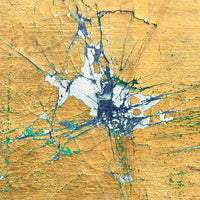ーWhat is a Pigment?
In simple terms, pigments are colorant in powder form. It does not dissolve in water. When applied to paper or canvas by itself, it will not be fixed on them. Only when mixed with a binder, can it be used as paint.
Unlike dyes, pigments are not suitable for dyeing fabrics.
Most pigments found in the PIGMENT TOKYO store are made as painting material for fine art.
ーHow do you use Pigments?
By mixing pigments with a binder (also known as a painting medium), you create "paint". The tube paints that you are familiar with are made by combining pigments with a binder and other ingredients.
There are no pigment and binder combinations that should be avoided, but some pairings work better together than others. Please check out the related article below and experiment with making paints that fit your artistic style.
[Related article] PIGMENT ARTICLES
The ABCs of Art Materials ーPainting Mediumsー (Q. What is the best way to choose?)
How to Make Your Own Paint
ーWhat Types of Pigments are Available?
At PIGMENT TOKYO, we mainly offer three types of pigments: Mineral Pigments used for Japanese-style painting, Pigments for watercolors and oil paints, and Effect Pigments which have luminosity and sheen.
・Mineral Pigments (Iwa-Enogu)
There are again three types: Natural Mineral Pigments derived from minerals, Artificial Mineral Pigments made from artificial materials such as glass, and Lead-free Mineral Pigments (Kyojyo Iwa-Enogu).
These pigments are known for their opacity and sandy, granular texture.
The raw materials are ground into powder and classified into ten grades based on particle size. As the grade number increases from 5 to 13, the particles become finer, with the letter “Byaku, 白” which means white, representing the finest powder.

[Related article] PIGMENT ARTICLES
Iwa-Enogu, an Essential Coloring Material for Nihonga
Particle Sizes of Mineral Pigments: Gum Arabic and Acrylic Emulsion
・Pigments (Fine Particles)
A general term for color powders used in all types of tube paints available on the market, including watercolors, acrylics, and oil paints. These pigments have fine particles, giving them a smooth texture. Additionally, many of these pigments offer vibrant colors with high saturation and a wide range of hues is available. Most of these pigments are chemically synthesized, so naturally derived pigments are relatively limited.
・Effect Pigments
These pigments are based on mica, metal, and glass, and were developed from the technology used in industrial products and automotive coatings. They offer a variety of visual effects, including the shine of metals or pearls, changes in color and luster depending on the viewing angle, and even the ability to glow in the dark.
[Related article] PIGMENT ARTICLES
Effect Pigments —Properties and How to Choose—
· Others
In addition to the above pigments, PIGMENT TOKYO also offers Earth Pigments, made from natural soil, and Suihi Pigments which are made from colored Itabo oyster shells.
[Related article] PIGMENT ARTICLES
Colors of the Earth —A Journey with the Natural Earth in Search of Color—
Suihi: the Elements of Paint
ーHow Much is 15g of Pigment?
At PIGMENT TOKYO, we sell pigments by 15g units, but their volume varies depending on the material and particle size.
Although the pigments in the image below are all 15g, their volume looks different.
Additionally, when used as paint, finer pigments tend to have better spreadability, allowing you to cover a larger area with a smaller quantity compared to coarser pigments.

ーWhat are C.I Name and C.I Number?
There is a pigment classification system named Color Index Name published by a council of color material suppliers in the U.K. and the U.S. It is also called C.I. Name for short, and color materials are categorized according to the pigments used.
Moreover, pigments are sometimes classified according to their chemical structure, known as the C.I. Number.
Many art material manufacturers write one or both of these identifiers on their catalogs and paint tubes.
This information helps us better understand the properties and composition of pigments from a scientific perspective.
ーWhat Are the Safety and Hazards of Pigments?
The safety and hazards of pigments are evaluated based on the GHS (Globally Harmonized System of Classification and Labelling of Chemicals).
This is a global system used to classify the hazards and toxicity of chemicals, and the information is provided on safety labels and data sheets.
PIGMENT TOKYO does not carry extremely toxic pigments according to GHS standards, however, we recommend wearing a mask while working with pigments and cleaning and ventilating the room after use.
For more information on GHS, please refer to your country’s health and chemical-related authorities.
Translated by Kainuma Chiaki and Atsumi Okano


